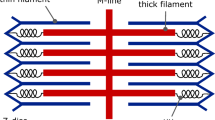Summary
In a very short skeletal muscle of frog, isometric contractures were induced electrically by the method ofKavaler. At all phases of the contracture, the muscle was released to 98% of its original length. The initial rise (Δk) in tension of the recovery contracture which follows the sudden drop in tension during release is considered as a measure for the contractility at any instant in the course of contracture. If allowance is made for the visco-elastic aftercontraction present also in the resting muscle, the Δk values vary with time in the following manner: a) Immediately after the beginning of depolarisation, they rise to a peak, from which they fall to zero very steeply, when the duration of depolarisation is short. b) During long depolarisation, they decline to a plateau and fall again after repolarisation. c) Independently of the duration of the depolarisation, the Δk values reach the zero line long before relaxation is completed, but they overlast the depolarisation time in all cases. From these results, the conclusion is drawn that the decline of contractility to zero needs a certain time after repolarisation. This delay explains the fact, that very short depolarisation impulses are effective only as trigger for the mechanical response, while long lasting depolarisations are essential for the maintenance of the tension developed actively.
Zusammenfassung
In einem sehr kurzen Skeletmuskel des Frosches wurden isometrische Kontrakturen auf elektrischem Wege nach der Methode vonKavaler ausgelöst. In allen Phasen der Kontraktur wurde der Muskel auf 98% seiner ursprünglichen Länge entdehnt. Der initiale Spannungsanstieg der „Recovery-Kontraktion”, die auf den plötzlichen Spannungsabfall während der Entdehnung folgt, wird als Maß für die Kontraktionsfähigkeit zu jedem Augenblick im Verlauf der Kontraktur angesehen. Wenn die „viscoelastische” Nachkontraktion abgezogen wird, die auch im ruhenden Muskel vorhanden ist, zeigen die Δk-Werte folgende Zeitabhängigkeit: a) Unmittelbar nach dem Beginn der Depolarisation steigen sie zu einem Gipfel an, von dem sie sehr steil auf Null abfallen, wenn die Dauer der Depolarisation kurz ist. b) Während lang anhaltender Depolarisation laufen sie in ein Plateau ein und fallen aufs neue nach der Repolarisation ab. c) Unabhängig von der Dauer der Depolarisation erreichen die Δk-Werte die Nullinie, bevor die Erschlaffung vollendet ist, aber sie überdauern in allen Fällen die Depolarisationszeit. Aus diesen Ergebnissen wird der Schluß gezogen, daß der Rückgang der Kontraktionsfähigkeit auf den Nullwert nach der Repolarisation einen gewissen Zeitbedarf hat. Diese Verzögerung erklärt die Tatsache, daß kurze Depolarisationsimpulse nur als „Trigger” für die mechanische Antwort wirken, während langdauernde Depolarisationen für die Aufrechterhaltung der aktive entwickelten Spannung essentiell sind.
Similar content being viewed by others
Literatur
Bleichert, A., u.H. Reichel: Über den zeitlichen Verlauf der Aktivierung im Herzmuskel. Verh. dtsch. Ges. Kreisl.-Forsch.23, 356–359 (1957).
—— Die Hemmung der Erschlaffung beim Herzmuskel des Kalt- und Warmblüters. Pflügers Arch. ges. Physiol.276, 242–249 (1962).
—— u.H. Ballhorn: Über elektrisch ausgelöste Kontrakturen am Skeletmuskel des Frosches. Pflügers Arch. ges. Physiol.282, 225–231 (1965).
Dudel, J., M. Morad, andR. Rüdel: Contraction of single cray fish muscle fibers induced by controlled changes of membrane potential. Pflügers Arch. ges. Physiol.299, 38–51 (1968).
Edman, K. A. P., D. W. Grieve, andL. Nielsson: Studies of the excitationcontraction mechanism in the skeletal muscle and the myocardium. Pflügers Arch. ges. Physiol.290, 320–332 (1965).
Hasselbach, W., u.M. Makinose: Die Calciumpumpe der Erschlaffungsgrana des Muskels und ihre Abhängigkeit von der ATP-Spaltung. Biochem. Z.333, 518 bis 528 (1961).
Hill, A. V.: The abrupt transition from rest to activity in muscle. Proc. roy. Soc. B136, 399–419 (1949).
— Trails and trials in physiology. Baltimore: The Williams and Wilkins Comp. 1965.
Kavaler, F.: Membrane depolarisation as a cause of tension development in mammalian ventricular muscle. Amer. J. Physiol.197, 968–970 (1959).
Morad, M., andW. Trautwein: The effect of the duration of the action potential on contraction in the mammalian heart muscle. Pflügers Arch. ges. Physiol.299, 66–82 (1968).
Reichel, H., A. Bleichert u.H. Reichel: Das Release-Recovery-Phänomen am Uterusmuskel der Ratte. Z. Biol.114, 210–215 (1963).
—,A. Zimmer u.A. Bleichert: Die elastischen Eigenschaften des Skelet- und Herzmuskels in verschiedenen Phasen der Einzelzuckung. Z. Biol.108, 188 bis 195 (1956).
Ritchie, J. M.: The effect of nitrate on the active state of muscle. J. Physiol. (Lond.)126, 155–168 (1954).
Rumberger, E.: Über Korrelationen zwischen der Aktionspotentialdauer und dem zeitlichen Verlauf der Erschlaffung beim Herzmuskel des Warm- und Kaltblüters. Pflügers Arch. ges. Physiol.301, 70–75 (1968).
Sonnenblick, E. H., andZ. T. McCallum: Active state, force velocity relationship and inotropic mechanism in mammalian papillary muscle. Fed. Proc.45, 126 (1961).
Author information
Authors and Affiliations
Rights and permissions
About this article
Cite this article
Bleichert, A., Reichel, H. Der Zeitverlauf der Kontraktionsfähigkeit des Muskels nach plötzlichen Entdehnungen während elektrisch ausgelöster Kontrakturen. Pflugers Arch. 303, 99–107 (1968). https://doi.org/10.1007/BF00592628
Received:
Issue Date:
DOI: https://doi.org/10.1007/BF00592628




